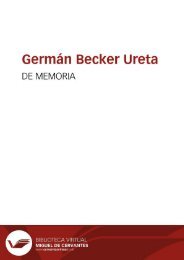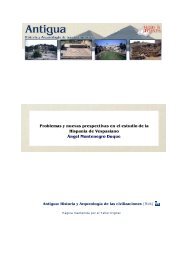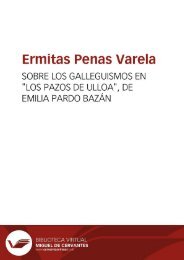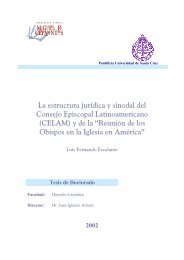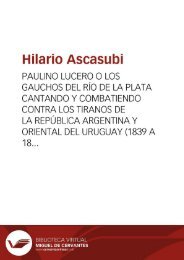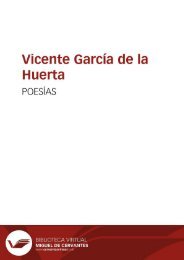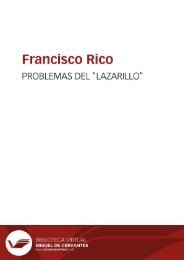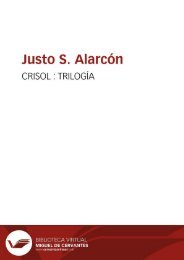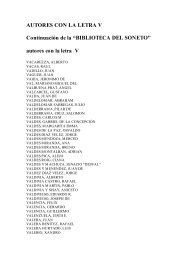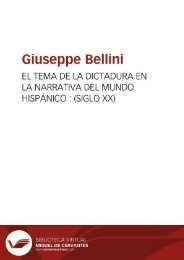Create successful ePaper yourself
Turn your PDF publications into a flip-book with our unique Google optimized e-Paper software.
Anales galdosianos [Publicaciones periódicas]. Año XII, 1977<br />
material, full of potential, that can be misshapen or admirably developed, according to the creative<br />
circumstances. She, too, is estheticized: « la tristeza que despedían sus bonitos ojos, aquella tristeza<br />
que a veces me parecía un efecto estético, producido por la luz y color de la pupila, a veces un resultado<br />
de los fenómenos de la expresión, por donde se nos transparentan los misterios del mundo moral,<br />
quizás revelaba uno de esos engaños cardinales en que vivimos mucho tiempo, o quizás toda la vida,<br />
sin darnos cuenta de ello » (VI, 39). Irene is projected not as a creature of flesh, but as a phenomenon<br />
of esthetic, linguistic expression. The statement also adduces that art, here in the shape of Irene, is<br />
the affirmation of life's mysteries and that arts deceit, its ambiguity, is inherent and sustains us. That<br />
power of art forges the supernatural oneness that exists between creator and creation. « La llevaba<br />
conmigo », writes Manso of Irene in terms even more explicit than his expressions of solidarity<br />
with Manuel. « Era como si la naturaleza de ella hubiera sido inoculada milagrosamente en la mía.<br />
La sentía compenetrada en mi, espíritu con espíritu » (XVII, 104). The long conversation between<br />
Máximo and Irene in which the details of her relationship with Peña are revealed is for all intents<br />
and purposes Irene's confession, but it comes from the mouth of Manso. It is as if he were reciting a<br />
drama whose script he had composed. This retrospective account that abounds in evidence of Manso's<br />
omniscience prompts Irene to exclaim twice: « -Sabe usted... más que Dios... »; « -Usted lo sabe<br />
todo... Parece que adivina... » (XLI, 256, 258). The reader is not so surprised.<br />
The creator's control over his creation, however -whether that creation is a pupil, an ideal, or a<br />
fictional character- is tenuous. Through Manolo, the pupil (the idea) is portrayed as potentially willful<br />
and rebellious, and the teacher (the artist) must conquer and tame in order to shape. In the course<br />
of the educational process, Manso discovers that he needs to adjust to his pupil's innate gifts. He<br />
cannot squeeze polished writing out of oratorical talent, and he cannot fan speculative interests where<br />
pragmatic inclinations persist. Even the name by which Manolo is most frequently called, Peñita, is<br />
given him by someone else and in spite of Manso's distaste for it. Small incidents these, yet proof<br />
that the artistic raw material is refractory from the start and subject to the interference of third parties.<br />
In Irene's case, too, Manso constructs her in a given fashion, as a woman of the North, free of his<br />
society's enervating moral climate: « He aquí la mujer perfecta, la mujer positiva, la mujer razón,<br />
contrapuesta a la mujer frivolidad, a la mujer capricho » (XIII, 77). Yet Manso is prompted to<br />
wonder: « ¿Acaso la conozco bien? No; cada día noto que hay algo en ella que permanece velado a<br />
enthusiasm for the gestures, the flowery phrasing, the empty metaphors that lead him. to ask twice «<br />
¿de qué hablaba? » and that in others he had relentlessly condemned? Only his instinctive recognition<br />
of the symbiotic dependency between creator and creation can serve as an adequate explanation.<br />
101



